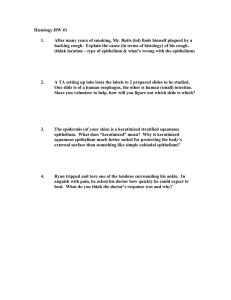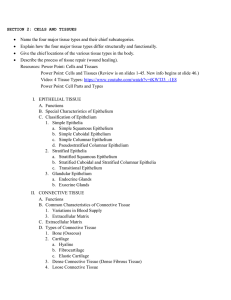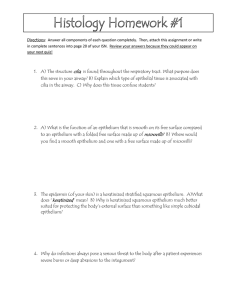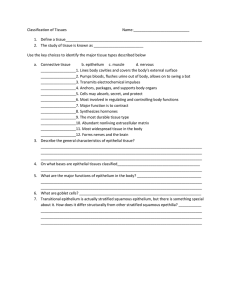Exercises 3-6: Review & Practice 1
advertisement
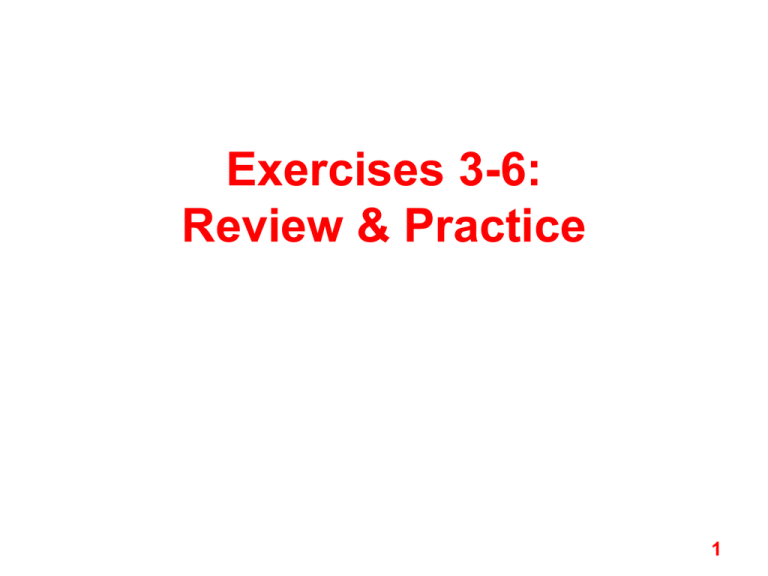
Exercises 3-6: Review & Practice 1 Exercise 3 (Microscopy) 2 The microscope • Care and use of the microscope-• Be familiar with parts of the microscope. • For example--Identify following parts: Rotating nosepiece, Condenser, and Iris diaphragm (See next slide) 3 4 ID the component of a microscope 1. ______ used for precise focusing once initial focusing has been done 2. ______ delivers a concentrated beam of light to the specimen 3. ______ carries the objective lenses; rotates so that the different objective lenses can be brought into position over the specimen 4. ______ Used to increase the amount of light passing through the specimen 5. ______ platform on which the slide rests for viewing Choose from: A--condenser; B--fine adjustment knob; C--iris diaphragm; D--mechanical stage; E-nosepiece Practice01 5 Viewing objects through microscope 1. Move the slide to the left. In what direction does the image move? 2. Away from you― move toward you 3. Draw “e” on a slide― What would the image look like in the low-power field? 4. Draw “k” on a slide― Image? 5. Total magnification—power of the ocular lens multiplied by the power of the objective lens used. 6 Practice questions on microscopy 1. The distance from the bottom of the objective lens in use to the specimen is called the ___. 2. The area of the specimen seen when looking through the microscope is the ____. 3. Assume there is an object on the left side of the field that you want to bring to the center. In what direction would you move your slide? 4. If, after focusing in low power, only the fine adjustment need be used to focus the specimen at the higher powers, the microscope is said to be _______. 5. If a microscope has a 10X ocular and the total magnification at a aprticular time is 450X, the objective lens in use at that time is _____X. Practice02 7 Exercise 4 (Epithelial Tissue) 8 Review 9 10 11 Simple Epithelia 12 1. Simple squamous epithelium Locations-- air sacs of lung, inner lining of blood vessels, lining of peritoneum, serous membrane of stomach and small intestine 13 14 15 16 2. Simple cuboidal epithelium Locations– kidney tubules, duct of pancreas, thyroid gland 17 18 19 20 21 22 3. Simple columnar epithelium Locations– inner lining of stomach and intestines, uterine tubes 23 24 25 26 4. Pseudostratified columnar epithelium Locations– Respiratory tract from nasal cavity to bronchi 27 28 29 Stratified Epithelia-Composed of more than one layer of cells & named for shape of surface cells 30 5. Stratified squamous epithelium Locations– Epidermis, palms and soles; tongue, esophagus, vagina 31 § 5A. Keratinized Stratified Squamous Fig. 5.8 Skin from the sole of the foot • Layers of epithelium covered with compact, dead squamous cells (no nuclei) packed with protein keratin • Retards water loss, prevents entrance of organisms • Forms epidermal layer of skin (esp. soles and palms) 32 33 § 5B.Nonkeratinized Stratified Squamous Epithelial layer Fig. 5.9 Mucosa of the vagina • Multilayered epithelium that lacks surface layer of dead cells forming moist, slippery layer • Locations: tongue, oral mucosa, esophagus & vagina 34 35 6. Stratified cuboidal epithelium Locations– Sweat gland ducts, ducts of the esophageal gland, follicles of ovaries, seminiferous tubules of testis 36 37 38 39 40 § 6. Stratified Cuboidal Epithelium Fig. Ovarian follicles • (Structure) Two or more layers of cells; surface cells square or round • (Functions) Secretion and production • (Locations; ducts of) Sweat gland, ovarian follicles 41 7. Stratified columnar epithelium Locations– Male urethra and in ducts of some large glands 42 43 44 8. Transitional epithelium Locations– urinary tract, ureter, bladder, umbilical cord 45 46 47 Fig. 5.11b Copyright © The McGraw-Hill Companies, Inc. Permission required for reproduction or display. Basement membrane Connective tissue Binucleate epithelial cell (b) 48 Figure 5.11a 49 Figure 5.11b 50 Practice 51 ID#1-- ID this type of epithelium and name ONE representative location. 52 ID#2-- ID this type of epithelium and name ONE representative location. 53 ID#3-- ID this type of epithelium and name ONE representative location. 54 ID#4-- ID this type of epithelium and name ONE representative location. 55 ID#5-- ID this type of epithelium and name ONE representative location. 56 ID#6– ID this type of epithelium and name ONE representative location. 57 ID#7-- ID this type of epithelium and name ONE representative location. 58 Exercise 5 (Connective Tissue) 59 Review 60 §1-- Areolar Tissue Fig. Mesentery • Loose arrangement of collagenous and elastic fibers; scattered cell types; abundant ground substance • Locations-- Underlying all epithelia; surrounding 61 nerves, blood vessels, esophagus, trachea Figure 5.16b §2-Adipose tissue Fig. Adipose tissue 62 §3-- Reticular Tissue • Loose network of reticular fibers and cells • Forms structural supportive stroma for lymphatic organs • Locations-- lymph nodes, spleen, thymus & bone marrow Fig. Spleen 63 §4-- Dense Regular CT Fig. Tendon 64 §5-- Dense Irregular CT Fig. Dermis of the skin 65 Figure 5.19b §6– Hyaline Cartilage Fig. Fetal skeleton 66 Figure 5.20b §7– Elastic Cartilage Fig. External ear 67 Figure 5.21b §8– Fibrocartilage Fig. Intervertebral disc 68 §9– Bone Canaliculi ? Fig. Compact bone 69 Practice 70 ID#8-- ID this type of C.T. and name ONE representative location. 71 ID#9-- ID this type of C.T. and name ONE representative location. Figure 5.15b 72 ID#10-- ID this type of C.T. and name ONE representative location. Figure 5.16b 73 ID#11-- ID this type of C.T. and name ONE representative location. 74 ID#12-- ID this type of cartilage and Figure 5.19b name ONE representative location of this type of connective tissue. 75 ID#13-- ID this type of cartilage and name ONE representative location of this type of connective tissue. 76 ID#14– ID this type of cartilage and name ONE representative location of this type of connective tissue. 77 ID#15– ID tiny “holes” (A), hair like structure (B), and (C) indicated respectively by arrows. C B A 78 Exercise 6 (Integumentary System) 79 Review 80 Skin model Skin Model A–Epidermis; B—Dermis; C—Hypodermis; 1– Meissner’s corpuscle; 2– Pacinian corpuscle; 3– Eccrine sweat gland; 4– Sebaceous gland; 5– Hair follicle; 6– Arrector pili muscle 81 82 Meissner’s corpuscle 83 84 Dark skin with lots of melanin 85 Thick skin– Keratinized stratified squamous epithelium 86 Practice 87 ID#16– Name the major function of this structure (circled). Figure 6.1 88 ID#17—ID this specific type of receptor (circled) and name its function in the skin. 89 ID#18– ID this connective tissue layer braced in black ink below. Figure 6.1 90 ID#19-- ID this layer (pale appearance) that is indicated by the red arrow and the red brace. ID#20-- ID this layer (dark brown color) that is indicated by the black arrow and the black brace. 91 The epidermis ID#21--ID this cutaneous gland. 92 ID#22– ID the indicated structure. 93 ID#23– ID the indicated structure. 94

